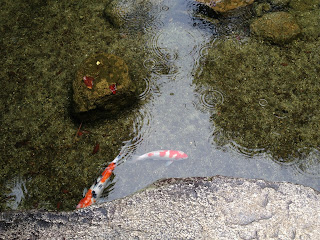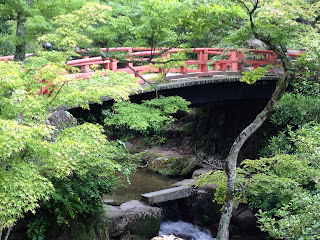-- Susan, every other Sunday
I love koi.
 |
| Painted koi at ryokan Iwaso, Miyajima, Japan |
Ever since I was small, I’ve been drawn to ponds with colorful fish,
especially Japanese painted koi. I adore their colorful scales and tranquility, and (like all aquatic creatures) I find them fascinating.
They glide through the water with the
grace of kings, yet beg like children when people approach with treats.
The word “koi” is actually Japanese for “carp.” In Japan, the colorful
koi you often (read: always) see in ponds are nishikigoi, or
“brocaded carp,” and although they originated as food, the Japanese have kept
them as domesticated ornamental fish for hundreds of years.
 |
| Beautiful AND delicious (or so I'm told.) |
In fact, koi are so ubiquitous in Japan that any time you see a body of water large enough to physically hold one, it's a fairly safe bet you'll find a koi (or a dozen) swimming in its depths.
During last year's research trip to Japan, I realized, yet again, exactly how
prevalent these lovely fish are in Japanese temples:
 |
| Koi at Eikan-do |
gardens:
 |
| Koi at Myoman-ji (Kyoto) |
streams:
 |
| Koi in the canal along the Philosopher's Path, Kyoto |
and ponds:
 |
| No, really. EVERYWHERE. |
Shoguns often placed koi in the ponds adjacent to their private gardens. Descendants of those fish still swim in the pond outside Ninomaru
Palace, on the grounds of Kyoto's Nijo Castle:
 |
| You can't see the koi in this picture, because someone else was standing closer to the water and they were begging. |
Japanese koi have little fear of humans, and beg shamelessly for treats, which
makes them easy to photograph—like this large school at Kyoto’s Eikan-do Temple:
 |
| This is an average-sized school for most temple ponds. |
 |
| You're planning to feed us, right? |
Wild koi also swim in the canal along the philosopher’s path, a 2-mile
trail that winds past several of Kyoto’s famous shrines and temples.
 |
| These koi were over 2 feet long. |
The koi in Kyoto's canals and rivers are often brown or white instead of brightly colored, because within two wild generations painted koi will actually lose their color and revert to solid, darker shades
that provide more camouflage. The lovely colors we see in the decorative versions are maintained through careful, selective breeding.
The loveliest koi I saw in Japan were swimming in a pond outside Ryokan
Iwaso on Miyajima, a sacred island off the coast of Hiroshima.
 |
| Painted carp in rain. |
Not only did
these fish display the iconic red and white patterning so common in Japanese
paintings, but their large size and calm demeanor made them peaceful to watch.
Add in early morning rain, and it’s hard to imagine a more idyllic scene.
In Japanese culture, the koi pond offers a pool of calm
to aid in Zen reflection and a retreat from the frantic pace of life. Koi live long lives--the oldest ever recorded was a female koi named Hanako, who died in 1977 at the age of 226. Watching fish can lower blood pressure and reduce stress chemicals in the human brain, which means their peaceful existence can help us live longer lives as well.
Yet another reason to love koi.
















We love koi here, too. We (I) dug a garden pond (by hand) almost 20 years ago, and the same koi have been living with us ever since. Not having a handy stream to keep it filled, we put in a rubber liner. About 10 years ago, a nutria (beaver-like animal also not native to this area) found our pond just as we left for a weeks vacation. When we got back, I had over 22 holes in the liner that we tried to patch (it was trying to dig a den into the side of the pond; fortunately we used a HEAVY-duty liner, but still). The patches have slowed down the leakage, but we've about given up and will probably replace the liner in the next year or two.
ReplyDeleteBut everything you say about koi, ponds, and peacefulness (and begging :-) is absolutely true.
How lovely, Susan. On your next trip, please take video so we can see them begging!
ReplyDeleteI had a little pond in my garden on Waverly Place and kept koi in it for twelve years. In winter we used to put in an electrical gizmo that kept the water from freezing at the bottom--the sort of thing one can put in the gutters of a roof so that ice doesn't clog the downspout. The little guys were a joy to behold, until a new neighbor moved in beside us with a cat. I came home from work one summer day and found the scene of a massacre in my garden. I could draw it from memory twenty years later. I never replaced the fish for fear of sacrificing more lives to the beast next door.
That's the sort of tale that inspires catricide, he said koily.
ReplyDeleteOn a very special birthday of mine, a childhood friend brought me a gift of a dozen koi from his koi pond to put in my farm pond. I didn't know what to do but thank him for his generosity. The snapping turtles and great blue heron thanked him even more.
ReplyDelete